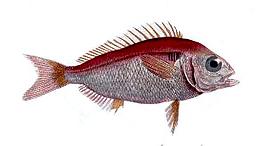Microcotyle centrodonti facts for kids
Quick facts for kids Microcotyle centrodonti |
|
|---|---|
| Scientific classification | |
| Genus: |
Bivagina
|
| Species: |
centrodonti
|
| Synonyms | |
|
|
Bivagina centrodonti is a tiny species of monogenean, which is a type of flatworm. It lives as a parasite on the gills of ocean fish. This means it lives on and gets its food from the fish, but it doesn't usually kill its host. Bivagina centrodonti belongs to a group of worms called the Microcotylidae family.
Contents
What is Bivagina centrodonti?
Bivagina centrodonti is a very small worm. It has a long, thin body that looks a bit like a thread. The body is symmetrical, meaning both sides are the same. It is wider in the middle and gets narrower at both ends.
How does it attach to fish?
The worm has a special part at its back called a haptor. This haptor helps the worm hold onto the fish's gills. It has many small clamps, usually between 120 and 160 of them. These clamps are arranged in two rows, one on each side of the haptor. At the front of the worm, there are two oval-shaped suckers that also help it attach.
What does it look like inside?
Like other animals, Bivagina centrodonti has different body parts to help it live. It has a mouth at the front and a muscular pharynx (like a throat). It also has an oesophagus and an intestine with branches that spread out. Each adult worm has both male and female reproductive organs.
Where does Bivagina centrodonti live?

This worm was first found on a fish called Pagellus bogaraveo. This fish is also known as the Red Sea Bream. The first worms were discovered in an aquarium in the English Channel. The English Channel is a part of the Atlantic Ocean that separates southern England from northern France.
Images for kids


